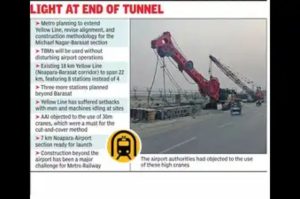Barasat Metro Project Overcomes – After years of delays, land acquisition hurdles, and technical roadblocks, the long-awaited Barasat Metro project is set to overcome its biggest challenge yet: the congested stretch near Netaji Subhas Chandra Bose International Airport. Thanks to the deployment of an advanced Tunnel Boring Machine (TBM), engineers are preparing to dig their way past the airport’s most sensitive underground zone without disturbing flight operations or compromising safety.

The East-West Metro corridor extension from Noapara to Barasat, passing through the airport, is among Kolkata’s most ambitious urban transport projects. For over a decade, the plan has been bogged down by the complexities of working under operational runways and ensuring minimal disruption to one of India’s busiest aviation hubs.
Barasat Metro Project Overcomes: The Airport Challenge
The core difficulty lies in tunneling beneath a highly secure and operational airport, where any ground movement can potentially affect runway stability. Civil engineers have had to contend with strict height restrictions for above-ground work, the inability to use large cranes near the airstrip, and a maze of underground utility lines that service the airport’s terminals.
The upcoming TBM operation aims to dig with millimeter precision, creating parallel tunnels that will serve up and down Metro lines. Special vibration-dampening techniques will be used to avoid disturbing runway soil compaction, and all work will be carried out under constant monitoring by both Metro Rail Kolkata authorities and the Airports Authority of India (AAI).
High-Tech Engineering Solutions
According to engineers from Rail Vikas Nigam Limited (RVNL), the agency overseeing the project, the TBM being used for the Barasat Metro stretch is equipped with advanced navigation systems that ensure precise alignment. The machine will also use a closed-face method to control soil pressure during excavation – a technique particularly crucial when working beneath airport tarmacs.
Special tunnel lining segments will be installed immediately after excavation to reinforce the passage. These pre-cast concrete rings are designed to bear both static and dynamic loads, ensuring the tunnel remains stable even under heavy aircraft landings.
Phased Completion Plan
The tunneling work under the airport is planned to be executed in phases:
- Initial Entry Point Construction – Creating secure TBM launch shafts away from the immediate vicinity of the runways.
- Controlled Boring Under Runways – Operating under a low-vibration, high-precision mode with 24/7 supervision.
- Connecting to Terminal Stations – Linking the tunnels to the proposed Airport Metro station, which will integrate with existing East-West Metro lines and the city’s suburban rail network.
- Extension to Barasat – Continuing the tunneling process beyond the airport zone towards Barasat to complete the corridor.
Impact on Commuters
Once operational, the Barasat Metro will drastically cut travel time for residents of North 24 Parganas and northern fringes of Kolkata. Presently, commuters rely on a mix of suburban trains, buses, and taxis, often battling heavy traffic on Jessore Road.
With the Metro, travel time from Barasat to Esplanade could be reduced to under an hour, compared to the current 2–3 hours during peak traffic. Moreover, the integrated network will provide direct connections to Sealdah, Howrah, Salt Lake Sector V, and other business hubs.
Economic and Environmental Benefits
The completion of this Metro stretch is expected to yield multiple benefits:
- Reduced Road Congestion – A significant drop in vehicular load on NH12 and Jessore Road.
- Lower Emissions – Shift from fossil-fuel-based road transport to electric-powered rapid transit.
- Economic Boost – Enhanced connectivity for airport employees, local traders, and passengers, making airport access faster and more reliable.
Urban planners believe the Metro will also encourage new residential and commercial developments in Barasat, Madhyamgram, and surrounding areas.
Past Delays and Political Oversight
The Barasat Metro project, sanctioned over a decade ago, has faced repeated delays due to funding issues, land disputes, and technical feasibility concerns. Several deadlines have been missed, leading to criticism from commuters and civic bodies.
However, recent coordination between the Ministry of Railways, RVNL, and AAI has accelerated progress. In the last year alone, multiple bottlenecks—including clearance for underground alignment and environmental impact assessment—have been resolved.
Public Sentiment
Commuters have expressed cautious optimism. “We have been hearing about this Metro line for years. If the tunneling under the airport finally happens without disruptions, it will be a game-changer,” said Subhajit Das, a resident of Barasat who travels to Salt Lake daily for work.
Airport taxi drivers have mixed feelings. While some fear a loss of business from passengers who currently rely on cabs, others believe the Metro will reduce congestion and bring more flight traffic to Kolkata.
International Parallels
Globally, tunneling under airports is not unprecedented. Examples include:
- London Heathrow Airport – The Piccadilly Line of the London Underground operates tunnels under the airport with minimal disruption.
- Tokyo Haneda Airport – Uses similar TBM technology to ensure safe underground rail passage.
- Hong Kong International Airport – Integrated high-speed rail tunnels with strict vibration control measures.
Kolkata’s project is set to follow these best practices, adapting them to local soil and weather conditions.
The Road Ahead
Officials expect the tunneling under the airport to take 12–15 months, followed by track laying, electrification, and trial runs. If no further setbacks occur, the Barasat Metro stretch could be operational by 2028.
The next big challenge will be ensuring smooth integration with existing Metro lines and ticketing systems. Authorities are considering a unified smart card system for seamless transfers between lines and transport modes.
Further Reading
- Kolkata Metro Projects – Ministry of Railways
- Airports Authority of India – Infrastructure Guidelines
-
Urban Transport Infrastructure in India – NITI Aayog Reports
Also read: Home | Channel 6 Network – Latest News, Breaking Updates: Politics, Business, Tech & More

